Difference between 4L60E and 4L80E (4l60e vs 4l80e) – In Details
They are both car transmissions, but they are wildly different in some of their features. Will it be possible to swap them? We will discuss all that in this article.
Both of these transmissions may look the same in the pictures; you will find many differences between the two. The ones mentioned are the major ones you can go in-depth for further research.
To know about the differences between the two, and to learn about how to swap one with the other, you need to have a basic idea.
You need to get the hang of the build, the construction, and the working mechanism of the two. Then and only then you will be able to identify their differences, as well as similarities.
So for that reason, a detailed description has been provided of both kinds of transmissions. Then, their differences have been mentioned, followed by similarities and swapping.
4L60E transmission details

The 4L 60 E transmission was introduced in 1992. It was basically an upgrade of the 700R4 transmission. They were almost the same.
The only difference between 700R4 transmission and 4L 60 E transmission was that the former was the hydraulic transmission, the latter was the electronic transmission.
The 4L 60 E transmission was available for smaller vehicles, like SUVs. Basically, it was available for all rear-wheel-drive cars.
There were many advantages of the 4L 60 E transmission. For one, it was cheaper, not only to buy but also because of its fuel consumption capabilities.
It didn’t consume a lot of fuel, and the consumption remained economical. That is why it was widely used in lighter vehicles.
One problem with it was that the 4L 60 E transmission doesn’t have quite the ability to use the reverse gear. That happens because of the debris build-up.
It also fails to perform at high speeds and high power. That is where the 4L 80 E transmission comes to show.
4L 60 E performance specs
The 4L 60 E transmission is designed so that it handles the torque of an engine that goes up to 360 lb-ft.
The name 4L 60 E indicates much about the part itself. The four, in the beginning, means that the transmission has a sum total of 4 gears. Next comes the L. L means that the transmission is oriented in a longitude manner. The 60 in the name means that 6000 pounds of GVW can be handled by the transmission.
Construction of 4L 60 E
The 4L 60 E was constructed from three pieces joined together, contrary to its predecessor, which was constructed out of a single piece.
The three pieces in 4L 60 E are the main case, the bell housing, and the tail housing. All of them are made from cast aluminum alloy.
This transmission is 21.9 inches long. Dry, the transmission is 146 pounds, and once the fluids are added, it weighs 162 pounds.
The amount of fluid to be added in the transmission depends mainly on the torque converter that the transmission is being used with.
If you are using a 9.64 torque converter, you will have to use 8.4 quarts of fluid. If you are using an 11.81 torque converter, you will have to use 11.4 quarts of fluid.
The 4L 60 E is an electronically controlled transmission that goes on four different speeds. It can be used in almost all rear-wheel drive vehicles.
Since it is easily available and very affordable, most of the vehicles you will see on the road have this transmission.
The 700R4 is still used in many vehicles; it has not gone out of date. That is because it used to be very popular. But for the most part, it is now replaced.
Read Also: Best Toyota Tacoma Tonneau Cover Review
4L 80 E transmission details

The 4L 80 E transmission came into being in 1991, as a replacement for TH400. The main difference between the two was that 4L 80 E came with overdrive capability, electronic controls, and lock-up torque converter.
The 4L 80 E transmission was almost similar to the 4L 60 E transmission, except the former was made to handle heavier loads and faster speeds.
The 4L 80 E transmission became popular for many reasons, and they were: Durability, better fuel consumption due to the overdrive feature, and ability to handle more torque.
All these features allow the 4L 80 E transmission to be used with high powered engines.
The 4L 80 E transmission still does not come without problems, though. The most common problems reported by the users are the hard shifting and the loose reverse gear.
4L 80 E performance specs
Why is 4L 80 E called 4L 80 E? The four means that the transmission is supposed to have four gears. The L means that it is oriented longitudinally.
The 80 indicates that the transmission is capable of handling 8000 pounds of GVWR. Finally, the E indicates that the transmission is controlled by electronic means.
Construction of 4L 80 E
The materials of all the transmissions are almost the same; the outer shell is made of cast aluminum.
The 4L 80 E differs from 4L 60 E in terms of construction due to the following reason: the b housing is integrated in 4L 60 E and cannot be removed.
The 4L 80 E transmission is significantly heavier than the 4L 60 E transmission having a dry w4L 80 E of 246 pounds.
The transmission fluid required for the operation of such a size is 6.8 quarts.
The 4L 80 E transmission also has cooling ports that allow for the transmission of oil coolers to be used.
Differences between 4L 60 E and 4L 80 E transmission
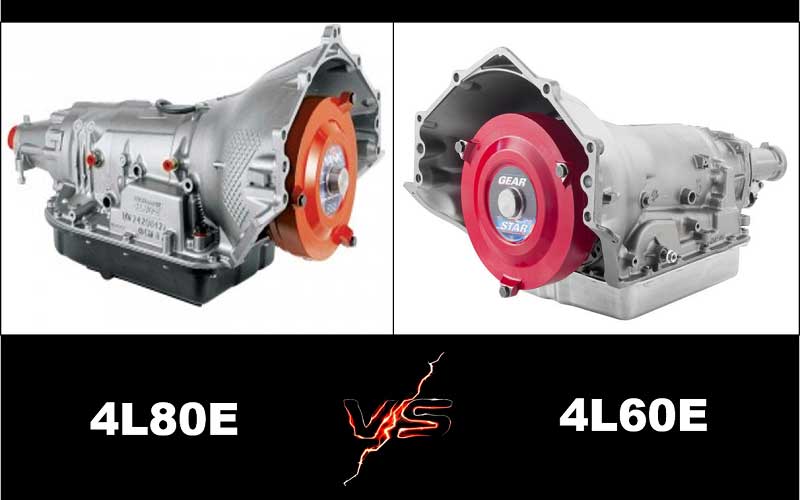
1. Origin
Despite the fact that they both have similar model numbers, they originated from different places. They are also manufactured differently.
Succeeding the 4L 80 E transmission, were the electronic overdrives of turbo 400. This early transmission model was used by hot rod enthusiasts and drag racers.
On the other hand, the 4L 60 E transmission was succeeded by 700-R4, which was the transmission of GMC and Chevrolet vehicles that began in 1982.
Read Also: Best Kinetic Recovery Rope review
2. W4L 80 E and size
One of the major differences between the two is the difference between the w4L 80 E and the size of the 4l60e and the 4l80e transmission. The 4l80e is a lot heavier and larger in size than the 4l60e.
The 4l80e has a w4L 80 E of 236 lbs, and the 4l60e has the w4L 80 E of 150 lbs. On the other hand, the 4l80e has a length of 26.4 Inches, and the 4l60e has a length of 23.5 inches.
By looking at these numbers, you can tell that a huge difference is there between the sizes and the w4L 80 Es of both of these transmissions.
3. The gear ratios
This difference is important to know if you are thinking about swapping one with the other. They have different gear ratios, so take note.
The 4l80e has the gear ratio of 2.48:1 on the first gear while the 4l60e has the gear ratio of 3.059:1 on the first gear.
It is possible to offer compensation for the new gear ratio by using another rear axle differential, so there won’t be a lot of problems.
Even though it doesn’t offer much of a difference, it still is good to know about when it comes to swapping transmissions.
4. Pan gasket and pan
Another good way to tell the difference between the 4l60e and the 4l80e is to look for their transmission fluid pans. This is a good way to tell whether you have a 4l80e or a 4l60e underneath your car.
You will find that the pan of 4l80e is more oval-shaped, with 17 bolts in them. On the contrary, the pan of 4l60e will be more rectangular and will be fitted with 16 bolts.
5. Maximum torque
Due to the difference in the sizes and w4L 80 Es of these transmissions, the torque will also be different. That also means there will be a gap between the durability of the two.
There are huge internals inside these transmissions. The 4L 60 E transmission is capable of handling the torque that goes up to 350 nm.
However, the 4L 80 E transmission can handle up to 450 nm, and sometimes more than that too. These numbers can vary depending on the age of the transmission.
The 4L 80 E transmission also offers more power than the 4L 60 E transmission. The vehicles with higher speeds and horsepower make use of 4L 80 E transmission.
For the stock vehicles, the 4L 60 E transmission will be good enough for working with the engine.
The older transmissions will not perform as well as the newer ones. It is to be considered that the condition of the transmission will wear out with time. So will the performance.
You will need to know the maximum torque before purchasing your transmission.
6. Controller, sensors, and wiring harness
If you probe deeper into the electronics of both of these transmissions, you will find differences of this sort. The wiring harness of one cannot be used with the other.
The sensors of both differ too. The 4L 80 E has two-speed sensors that the 4L 60 E doesn’t have. Before swapping, you need to purchase the harness and the control unit.
7. Price
Their prices differ because of the popularity of both. The 4L 60 E transmission is used more than the 4L 80 E transmission.
Moreover, the parts of 4L 60 E are more easily available than the parts of 4L 80 E. You can even find those in junkyards. For the parts of both of them, new or used, you should check amazon.
If you own a high power vehicle, then you should go for 4L 80 E because it is made for the engines that have a high horsepower. That is because it is larger in size.
If you put the 4L 60 E transmission at high speed and high horsepower vehicle, it will be prone to breaking.
Read Also: Best Portable Car Jump Starter Review
Similarities between 4L 80 E and 4L 60 E transmission
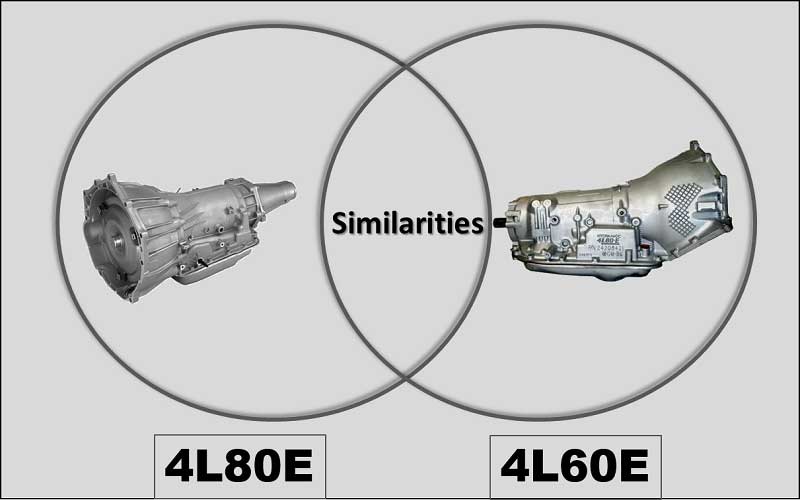
If you look at both of these transmissions from a distance, they do actually look alike. One similarity between the two is that they are controlled electronically.
The transfer cases of both of them have the same bolt pattern too. So swapping will not be much of an issue.
4L 80 E and 4L 60 E swap
Referring to the entire article above, these two have major differences between each other. So swapping will not be an easy plug and play.
There are many similarities that make swapping possible, yes. But there are also differences that have to be taken under consideration when you are swapping a 4L 60 E transmission with and 4L 80 E transmission.
These points may vary from model to model, so the swapping process can be altered. However, the general ones are as follows.
Transmission tunnel
The 4L 80 E transmission is bigger in size than the 4L 60 E one. So if you are to remove a 4L 60 E and replace it with the 4L 80 E, you will have to make a few adjustments.
The transmission on the car needs modification if that ought to happen. Sometimes, the models of the car arrive with both transmissions, and if that is the case, there isn’t much to worry about.
But if that isn’t the case, then you will have to use a welder and a hammer while fitting the 4L 80 E transmission.
Wiring harness
The wiring and sensors have huge differences between the two transmissions. If you are a beginner, you will have a hard time wiring the OEM wirings. This process consumes much time and effort.
The easy way to do that is by purchasing a swap kit harness. This may require you to invest some money, but it’ll be worth it since you will be saving yourself a lot of hassle.
Furthermore, you wouldn’t have to hire a professional for fixing it for you, so that levels it. You can purchase the swap kit easily from amazon.
Dipstick
The dipsticks of both of these transmissions are different. You need to purchase the one that goes with the 4L 80 E transmission. It can be found on Amazon.
Propshaft/driveshaft
The driveshaft of 4L 80 E is a lot longer than the one on 4L 60 E, so this is something that needs to be considered before swapping.
You can nick a driveshaft from one of the factories. If that is not an option, then there are many workshops that can cut the driveshaft shorter.
You can also shop for a driveshaft that is the same length as the one that you require. If you do, you may purchase that.
Read also: Best Surge Protector For RV Review
Torque converter/Flexplate
There can be two ways you can work around this issue. The first one is that you may purchase the special adapter kit, which contains an input shaft and a spacer that can work with your converter.
You may also use a torque converter or flexplate from the 4L 80 E transmission.
ECM
The engine control unit needs reprogramming and reflashing if it has to work in accordance with the 4L 80 E transmission.
You can get this job done by searching for a local dealer or surfing the web for one. The premade control units can also be used for this purpose, but they are quite expensive, for that matter.
If you also need to do other modifications for your engine, you should be allowing a tuner to do the transmission programming, while the engine is being turned on the dyno.
Cross-member
As it has already been mentioned, the 4L 60 E transmission case is shorter than the 4L 80 E transmission case. The cross member needs modification in that regard.
You may purchase an already made cross member. You may also make one yourself by using a welder.
Remember to line the transmission perfectly straight. There will be a difference depending upon the car model that you have and the models of the transmissions you are swapping.
Summary
If you need to conclude the entire article in simple words, then it can be said that the main difference between 4L 60 E and 4L 80 E is that, 4L 80 E is larger and stronger.
The main similarity between the two is only that they look strikingly alike, except the pan at the bottom, which is oval for one and rectangle for the other.
Considering you wish to swap one with the other, you will have to purchase as many parts that are compatible with the 4L 80 E transmission, like flex tape, converter, dipstick, etc.
Almost everything regarding the swapping process has been explicated in the article above, so you will not have a problem regarding that.
This is all that you needed to know about both the transmissions. Their origin, their working mechanisms, and then their differences and similarities, have been explained.
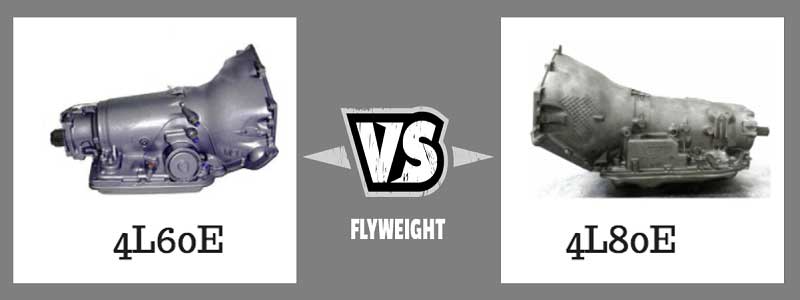

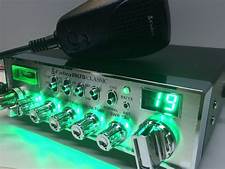

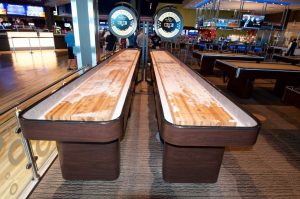
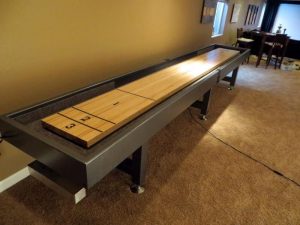
Post Comment